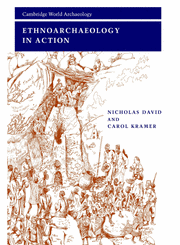Book contents
- Frontmatter
- Dedication
- Contents
- List of figures and credits
- List of tables
- Preface
- Acknowledgments
- Map
- 1 Ethnoarchaeology: its nature, origins, and history
- 2 Theorizing ethnoarchaeology and analogy
- 3 Fieldwork and ethics
- 4 Human residues: entering the archaeological context
- 5 Fauna and subsistence
- 6 Studying artifacts: functions, operating sequences, taxonomy
- 7 Style and the marking of boundaries: contrasting regional studies
- 8 Settlement: systems and patterns
- 9 Site structures and activities
- 10 Architecture
- 11 Specialist craft production and apprenticeship
- 12 Trade and exchange
- 13 Mortuary practices, status, ideology, and systems of thought
- 14 Conclusions: ethnoarchaeology in context
- Bibliography
- Index
10 - Architecture
Published online by Cambridge University Press: 05 March 2015
- Frontmatter
- Dedication
- Contents
- List of figures and credits
- List of tables
- Preface
- Acknowledgments
- Map
- 1 Ethnoarchaeology: its nature, origins, and history
- 2 Theorizing ethnoarchaeology and analogy
- 3 Fieldwork and ethics
- 4 Human residues: entering the archaeological context
- 5 Fauna and subsistence
- 6 Studying artifacts: functions, operating sequences, taxonomy
- 7 Style and the marking of boundaries: contrasting regional studies
- 8 Settlement: systems and patterns
- 9 Site structures and activities
- 10 Architecture
- 11 Specialist craft production and apprenticeship
- 12 Trade and exchange
- 13 Mortuary practices, status, ideology, and systems of thought
- 14 Conclusions: ethnoarchaeology in context
- Bibliography
- Index
Summary
The most urgent requirement at present is for detailed case studies that mediate between the ethnographers' structural models and the technologists' models of structures.
(Nicholas David 1971: 128–9).In this chapter we revisit some ethnoarchaeological studies, and introduce others that suggest ways in which archaeologists might think about architecture. Some of the topics we explore have to do with relationships between vernacular and other (especially state-run) building enterprises; relationships between built habitats and household size, organization, and economic status; the importance of sampling, and the “production” of space. We note that some ethnoarchaeological discussions of architecture consider gender, and a (very) few consider the building trades as crafts involving specialists. Most, but not all, of the accounts below are firmly in the processualist mode. One we will not consider, but which is suggestive of what might be done in postprocessualist mode, is Bourdieu's (1973) reading of the Berber house, an archetypal study of the Structuralist (with capital S and definitely not poststructuralist) school. This is hardly ethnoarchaeology, but rather a model distilled from the author's ethnographic experience.
“Vernacular” architecture
Archaeologists are drawn to architectural remains largely because they are sometimes comparatively substantial and well preserved. As such, they provide physical and humanly constructed contexts for artifacts and their spatial and chronological distributions.
- Type
- Chapter
- Information
- Ethnoarchaeology in Action , pp. 284 - 302Publisher: Cambridge University PressPrint publication year: 2001

